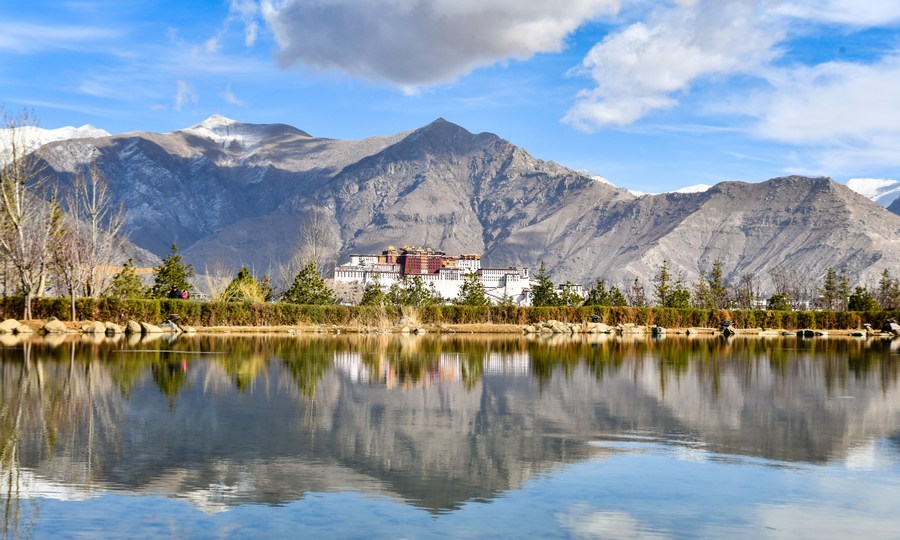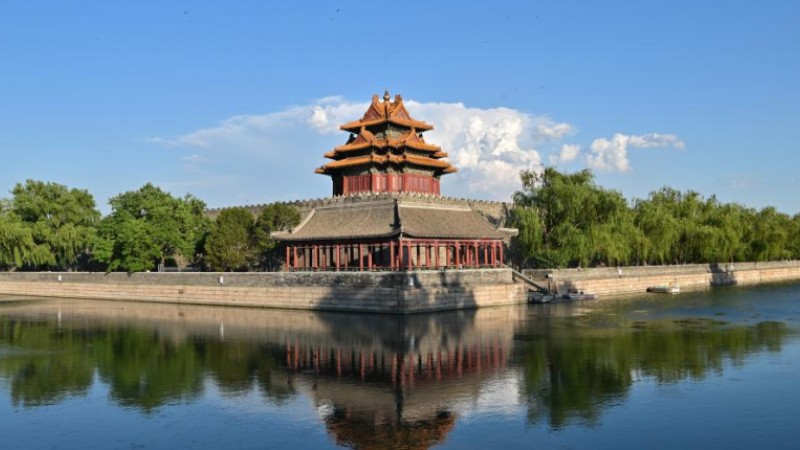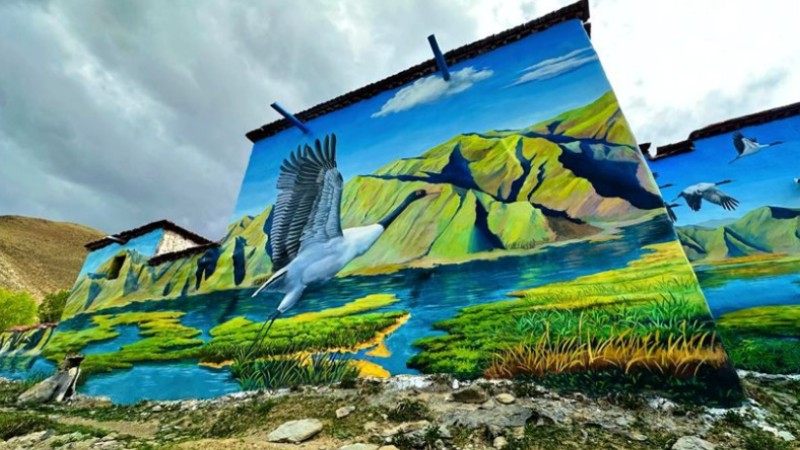Letter from Lhasa: A return after 14 years

This photo taken on Feb. 24, 2023 shows the Potala Palace in Lhasa, southwest China's Tibet Autonomous Region. (Xinhua/Jigme Dorje)
LHASA, July 27 (Xinhua) -- I arrived in Lhasa on a mid-summer day and basked in its sunny, mild weather and iconic landscapes: the red-and-white Potala Palace, the golden roof of the Jokhang Temple glimmering against the azure blue sky, and the quiet summer palace of Norbulinka.
In addition, I soaked up the crowds of pilgrims who walked clockwise along Barkhor Street encircling the Jokhang Temple while spinning their prayer wheels, and those who prostrated themselves on the ground, falling to their knees and then lying flat on their stomachs.
All these scenes were familiar, unchanged from my previous visit to Lhasa, dubbed "the city closest to the sun," back in 2009. Yet changes are easily noticeable in its streets, buildings and ambience.
In sharp contrast to the city I saw in the spring of 2009, bruised by a riot exactly a year earlier that left behind charred buildings, unfrequented alleys and traumatized residents, Tibetans and other ethnic peoples alike, Lhasa today, with its wide, neat streets, pedestrian bridges and underpasses, busy traffic, shopping centers, restaurants, and tea and coffee shops, is like any other metropolitan setting in the world, except for its slower pace, the smells of Tibetan incense in the air and bilingual road signs and storefronts.

Photo taken on May 10, 2022 shows trees in the Qomolangma National Nature Reserve in Zhaxizom Township in Tingri County, southwest China's Tibet Autonomous Region. (Xinhua/Sun Fei)
It was a pleasant surprise to see lush trees, grass and blooming flowers along Lhasa's streets and on the once-craggy mountains encircling the city proper. Plants used to be a luxury in the plateau region, including Lhasa, where the oxygen content in the air is only two thirds of the normal level. Yet thanks to the government's afforestation efforts and aid that has poured in from the rest of the country, Tibet has witnessed a remarkable increase in tree and grassland coverage over the years.
The post office, only a stone's throw from the Potala Palace, where I sent a postcard home every day for two weeks in 2009, was crowded with residents and tourists, eager to send letters, parcels and postcards.
Lhasa has seen an influx of tourists from different parts of the country this summer and I was already prepared for this after I found myself repeatedly trying to book a train ticket. Traveling to Lhasa by train was my dream ever since the world's most elevated plateau railway opened to traffic in 2006 and it was great to finally make the trip.
In the first five months of this year, Tibet, one of China's most sought-after tourist destinations, received more than 11.73 million visitors, a rise of nearly 45 percent year on year. The swarm of tourists also delivered huge profits to Tibet, as its tourism revenue over the period surpassed 13 billion yuan (about 1.8 billion U.S. dollars), up about 43 percent from the same period last year.
Tibet's aim for 2023 is to receive 39 million tourists and earn 51 billion yuan in tourism revenue for the year, the regional tourism authorities said.

A tourist poses for photos at Barkhor Street in Lhasa, southwest China's Tibet Autonomous Region, July 23, 2021. (Xinhua/Jigme Dorge)
Most tourists are drawn to the holy city by its unique Tibetan culture. Men, women and children are constantly seen wearing traditional Tibetan outfits posing for photos on Barkhor Street, with the Jokhang Temple in the background. They mingle with the crowds of pilgrims, presenting a typical image of Lhasa's city life today, which is a blend of the traditional and the modern, a mix of religious and secular lives, and a co-existence of diverse ethnic cultures.
This combination of traditional and modern Tibetan life is a feature and highlight in nearly every part of Lhasa. It can be seen in its cafes that sell espresso, cappuccino and Tibetan style yak-butter tea, in its gift shops that sell everything from gold ornaments, Tibetan wool carpets and dried yak meat, and in its clothing which combines Tibetan and Mandarin styles.
In a bookstore in the city center, I found two huge shelves of books, in Tibetan and Mandarin, from a publishing house that specializes in Tibetan studies. Among the best-sellers were poems written by the sixth Dalai Lama, Tsangyang Gyatso, born in 1683. What impressed me too were the Mandarin translations of several internationally renowned publications, such as "La Civilisation Tibetaine" by French author Rolf A. Stein and "A History of Modern Tibet" by Melvyn Goldstein.

A man hangs prayer flags on a mountain in Xigaze, southwest China's Tibet Autonomous Region, Jan. 24, 2023. (Xinhua/Jigme Dorje)
In the background, I heard a monotone voice repeating certain Tibetan words and phrases, an audio product that teaches people to speak the Tibetan language. All I could understand were "Tashi Delek," meaning "good luck," and "Thu-je-che," which means "thank you."
After a four-day road trip to visit Lake Yamzhog Yumco, Xigaze and the Mount Qomolangma Base Camp, I returned to my beloved Lhasa and spent a whole day reading and drinking tea in the garden of a Nepalese restaurant. I wished that day would never end.
A friend of mine said she was heartbroken when she boarded a flight home at the end of her very first visit to Lhasa nearly 20 years ago. "It was as if my body entered the cabin alone like an empty shell, but my soul stayed behind." A few months later, she quit her job and moved to Lhasa for good.
I feel her. Lhasa is a place that makes me cry every time I have to leave.
Photos
Related Stories
- Horse racing festival held in Yushu Tibetan Autonomous Prefecture, NW China
- Music festival energizes small town at foot of Mount Qomolangma
- Ecological tourism becomes pillar industry of village in Nyingchi, SW China's Tibet
- Open-air cinemas enrich cultural life of residents in SW China's Xizang
- 3D paintings add beauty to village in SW China's Xizang
Copyright © 2023 People's Daily Online. All Rights Reserved.









